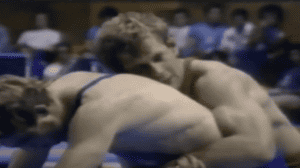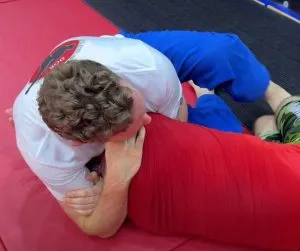The berimbolo has probably been the most popular move in Jiu Jitsu for the last twenty years. Especially with young athletic practitioners that like to compete.
Here is the history of one of the most popular techniques in modern Jiu Jitsu. We’ll first take you through how the berimbolo was first developed and detail the evolution it has gone through. Then at the end, we’ll go over various berimbolo techniques and list important details you cannot forget.
The History of the Berimbolo
The grappler credited with coming up with the berimbolo was 3x world champion Samuel Braga. When Samuel was starting out in Jiu Jitsu, he loved using the De La Riva guard.
One of the DLR sweeps he loved most was sweeping his opponents forward. But once his opponents started defending his sweep by stepping back, Braga had to come up with a counter.
What Braga first came up with was to roll as he was controlling their arm. This worked at first, but his opponent’s began hiding their arm and he started getting stuck on bottom.
Then when he was a purple belt, he began kicking forward to continue his roll and take his opponent’s back.
Braga would put his move to the test as a purple belt in the 2002 world championship. He would successfully hit the very first berimbolo roll in competition in the final roll to win the championship.
The Jiu Jitsu world was buzzing about this new move that he pulled off in competition.
Who came up with the name “Berimbolo?”
The name berimbolo was coined by BJJ legend Andre Galvao. In Portuguese, the word berimbolo means to scramble. It is an offshoot of the word berimbolar, which means the act of spinning.
The name stuck and from them on everyone in Jiu Jitsu referred to this roll as the berimbolo.
The Mendes Brothers
The next evolution of the berimbolo would be created by the Mendes BJJ brothers Rafael and Guilhereme. After they saw Samuel Braga pull the move off, they began making it part of their games.
One of the main points that Rafa and Gui added to the berimbolo was a leg drag. Once they completed the roll, they would pull themselves up using a leg drag to take their opponent’s back.
Along with their stellar guard games, the Mendes brothers would use the berimbolo to win multiple world titles.
The Miyao brothers
Berimbolo creator Samuel Braga gives a lot of credit to the Miyao brothers for revolutionizing the technique. In their interpretation of the berimbolo roll, they would use twister hooks and the crab ride position. A transitional position when done right allows you to take your opponent’s back or come up on top.
Berimbolo controversy
The original berimbolo roll had a little bit of controversy surrounding the technique in the early 2010s. In the original technique, you would underhook the opponent’s shin as you rolled through.
This would cause immense pressure on the opponent’s knee and led to a few injuries. The IBJJF would ban this underhook and would immediately disqualify any competitor that used it.
Competitors that used the berimbolo adapted to the new rule and began rolling without the underhook on the shin.
The Berimbolo for Beginners
A lot of BJJ practitioners that aren’t the most athletic tend to shy away from the berimbolo. Assuming that they don’t have the coordination to pull the move off.
The move is actually very easy to pull off. You just have to drill a few basic movements and then put them all together for the berimbolo.
Here are some basic drills you should practice before attempting berimbolo rolls.
Granby rolls
Granby rolls are basic movements you should be doing since you started Jiu Jitsu. You start a granby roll by sitting on the mat with your legs out.
Pick which side you want to roll on and put your arm behind your back. Then tuck your chin and roll over your shoulder. Be sure not to roll over your neck to avoid injury.
Once you begin your roll, use the momentum to roll sideways and finish in a sitting position like in the beginning. At first do granby rolls from side to side and when you get better at them, you can perform them in a circle.
Wall spins
The wall spin is basically a solo drill to practice inverting on your own. It is probably the perfect drill to practice berimbolos when you don’t have a partner to drill with.
First find a wall in your gym and put both of your feet on the wall. Then start your roll by tucking your elbow under your back.
Next step across the wall with your far foot and go into your roll. The elbow tuck and step across the wall makes you naturally invert and go into your roll.
You can roll back and forth or roll the length of the wall and go back.
Yoga ball rolls
Berimbolo rolls with a yoga ball are the same movement as on the wall, but with a less stable base. Practicing your berimbolo rolls with a yoga ball will help improve your balance.
Start by hooking your foot on the side of the ball and place your other foot on top of the ball. Place your hooking foot on the mat as you tuck your elbow and roll through.
Berimbolo partner drills
If you have a training partner available, this is probably the best drill you can do to work on your berimbolo. Your partner will be standing with their legs spread and you will be sitting with your legs around your opponent’s leg.
Start the roll by taking your inside arm and hooking it across your partner’s shin. Next roll to your shoulder and bring your inside foot between your opponent’s legs as you take your inside foot out.
Your momentum will naturally take you through the roll end the same way you started. At first go back and forth rolling between both legs and when you get good, you can berimbolo around your partner.
Basic Berimbolo from DLR
The original berimbolo that Samuel Braga created comes off a basic DLR back sweep. From the DLR guard, stretch your DLR hook in between your opponent’s leg and hook their far leg.
Then take a cross sleeve grip and kick them back to complete the sweep. From here, you are now in position to go into the berimbolo.
Before rolling, you first need to establish your grips. Grab your opponent’s pants behind their knee and grab their belt or pants.
Use the belt grip to pull yourself forward and bring your head as close as you can to their hip. The momentum from pulling yourself up using the belt grip will start your roll.
When you invert, you need to pinch your top knee down on your opponent’s leg to trap it in place. This keeps them from being able to take their leg out and defend your berimbolo roll.
To finish the roll, you need to hug your opponent’s back and grab under your opponent’s far knee. Pull their far leg towards you as you kick your legs forward to end the roll and take their back.
Berimbolo Defense Counter
If your opponent is savvy to the berimbolo, they might defend by sitting back. You can’t load their far leg the traditional way, so you will have to do the stomp.
Bring your inside hip to your opponent’s far hip and stomp your foot next to your opponent’s head. As you stomp down, you also kick your other leg and kick forward.
This causes your opponent to roll backwards and expose their hips. Secure their hips and switch your leg hook to a twister hook to push your opponent forward and take their back.
Berimbolo Defense Counter #2
Another common defense your opponent may do to defend the berimbolo is lay flat on their back. They do this when you grab their belt and start your roll. Which prevents you from inverting.
If they do this, you can change the direction of your roll and roll upwards to come out on top. When you’re on top, you can either pass to side control, or re-grip and go for another back take.
To do the back take, grab a pant grip on your opponent’s bottom leg and grab their collar behind their neck. These grips keep them in balance and stop them from attempting to reverse the position.
Now roll over your right shoulder as you keep your grips and invert. As you roll through, stomp down with both feet, get your hook and finish on your opponent’s back.
Mikey Musumeci’s Easy Berimbolo Roll
Another BJJ world champion that has found a lot of success using the berimbolo is Mikey Musumeci. Once he began training under Caio Terra, his berimbolo game was taken to another level.
He even developed his own easy variation of the berimbolo that doesn’t require you to be flexible or athletic. You start off in DLR guard holding your opponent’s ankle and also taking a cross collar grip.
When you pull down on their collar, your opponent will base on your knees and this is the reaction you want. You then use your collar grip to pull your opponent towards you and this takes their leg off the floor.
Now that your opponent’s foot is off the mat, you use your DLR hook and ankle grip to flip them over. A common reaction will be for your opponent to base on the mat with their hand after getting flipped.
To take your opponent’s back, secure their hips, hook your shin on their leg, and stretch them out. This puts you right in the back mount.
Berimbolo No-Gi
The berimbolo isn’t just a Gi technique, but can also be done in No-Gi Jiu Jitsu. It’s easier in the Gi due to the grips, but there are methods to pull it off in No-Gi.
A No-Gi berimbolo roll starts, the same as the traditional berimbolo from a double guard pull position. You grab your opponent’s ankle like in the traditional berimbolo roll, but the hip grip is a little trickier.
Since you don’t have a belt to grab, you must hug around your opponent’s hips.When you roll invert you pinch your legs together and trap your opponent’s leg just like in the Gi.
If your opponent lifts their back, you can go right to their back and establish control. But in No-Gi, you can’t force your opponent to expose their back like in Gi Jiu Jitsu.
So your two best options for doing the berimbolo No-Gi is to sweep or attack the legs. To sweep all you have to roll up to top position and get your two points, but your opponent may defend.
When they defend the sweep, they expose their legs and you can go right into a variety of leg attacks.
Important details for doing the berimbolo
The berimbolo really isn’t complicated, but you cannot forget any of the details or you won’t complete the roll. Here are the important details you need to remember for doing the berimbolo.
Your grips
The grips are the most important aspect of the berimbolo and even more so than the actual roll. Without your grips, you have no control of your opponent and cannot roll.
Control your opponent by grabbing their belt/hip and ankle/pant grip. Once you get these grips, you can go into your roll.
Head placement
Before you roll, your head needs to be placed right next to your opponent’s hip. If you try to berimbolo without putting your head near the hip, your roll will have no direction and look spazzy.
Trap the leg
Once you invert, you have to trap your opponent’s leg in place by pinching their leg between your legs. When you don’t do this detail, your opponent can backstep out of your berimbolo and end up on top.
Hip & leg control
As you go into the finishing sequence of the berimbolo, there are two important details you cannot forget. Controlling your opponent’s hip and their far leg.
The reason you control your opponent’s far leg is because you need to push it over to expose their back. Then as you push their leg, you must control their hip to keep them in place.
In Conclusion
The Berimbolo is one of the most popular moves in BJJ and in certain cases it is very effective in order to gain superior positions on an opponent. The most important element of the Berimbolo and least talked about is that the Berimbolo is a sport BJJ move and not for BJJ Self-Defense or MMA, as well as the best time to learn the Berimbolo is once you understand the fundamentals of BJJ as many young white belts and blue belts want to learn the Berimbolo only to find themselves being tapped or in a bad position when against a more advanced BJJ practitioner.
A truly eye-catching BJJ technique, the Berimbolo will continue to be a part of sport BJJ for the decades to come.




